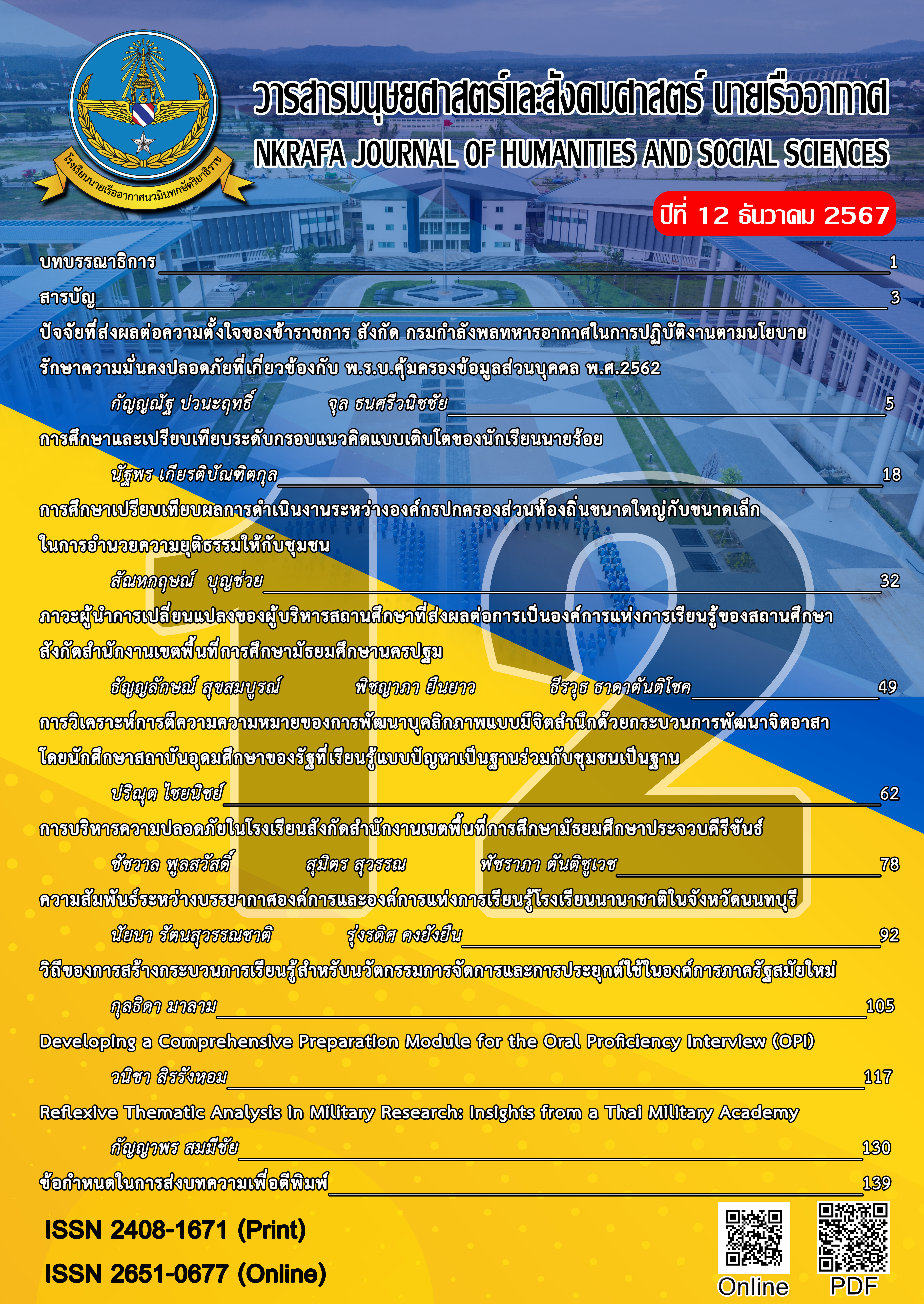A Study and Comparison of the Growth Mindset Levels in Cadets
Main Article Content
Abstract
The objectives of this study were 1) to study the teaching methods of instructors used in teaching cadets, and 2) to compare the level of the growth mindset among cadets when classified according to the teaching methods used by their instructors. The study utilized quantitative research methodology, with questionnaires serving as the primary data collection tool. Statistical analysis was performed using frequency values, percentages, and one-way ANOVA.
The research findings indicated the following:
1. Most of the sample group reported that the predominant teaching method used by instructors was the lecture format. However, the highest level of interaction occurred between the instructor and the cadets, with 242 cadets (62.40 percent) indicating that there was frequent mutual exchange of opinions. The second most common method involved cadets being assigned to present content as directed by the instructor, with 45 cadets (11.80 percent)
2. The comparison showed that the teaching method employed by the instructor, the results showed significant differences. Specifically, it was found that the growth mindset level of cadets who were taught using a lecture-based method as the primary teaching strategy differed from those who were taught with methods involving more mutual interaction between the lecturer and the cadets. This difference was statistically significant at the .01 level. Furthermore, when cadets were classified according to the teaching method, where the instructor was the primary lecturer, a notable difference was observed compared to methods where cadets were actively involved in creating content. This difference was statistically significant at the .05 level. Additionally, when cadets were assigned to present content as directed by the instructor, the growth mindset level also showed a significant difference at the .05 level.
Article Details

This work is licensed under a Creative Commons Attribution-NonCommercial-NoDerivatives 4.0 International License.
บทความที่ได้รับการตีพิมพ์เป็นลิขสิทธิ์ของวารสารมนุษยศาสตร์และสังคมศาสตร์ นายเรืออากาศ
ข้อความที่ปรากฎในบทความแต่ละเรื่องในวารสารวิชาการเล่มนี้ เป็นความคิดเห็นส่วนตัวของผู้เขียนแต่ละท่าน ไม่เกี่ยวข้องกับโรงเรียนนายเรืออากาศฯ และคณาจารย์ท่านอื่น ๆในโรงเรียนนายเรืออากาศฯ แต่อย่างใด ความรับผิดชอบขององค์ประกอบทั้งหมดของบทความแต่ละเรื่องเป็นของผู้เขียนแต่ละท่าน หากมีความผิดพลาดใด ๆ ผู้เขียนแต่ละท่านจะรับผิดชอบบทความของตนเองแต่เพียงผู้เดียว
References
จุฑาทิพย์ หาญกุดตุ้ม สมภารธัชธรณ์ ศิโลศรีไช และสัญญา เคณาภูมิ. (2566). การจัดการเรียนรู้โดยใช้คำถามเป็นฐาน. วารสารราชภัฏสุรินทร์วิชาการ, 1(5), 67-82.
ชนิตา รุ่งเรือง และ เสรี ชัดแช้ม. (2559). กรอบความคิดเติบโต: แนวทางใหม่แห่งการพัฒนาศักยภาพมนุษย์. วิทยาการวิจัยและวิทยาการปัญญา, 14(1), 1-13.
ทิศนา แขมมณี. (2555). ศาสตร์การสอน : องค์ความรู้เพื่อการจัดกระบวนการเรียนรู้ที่มีประสิทธิภาพ. กรุงเทพฯ : จุฬาลงกรณ์มหาวิทยาลัย.
นัฐพร เกียรติบัณฑิตกุล. (2565). ความสัมพันธ์ระหว่างกรอบคิดติดยึดและการรับรู้ความสามารถแห่งตนของนักเรียน นายร้อย. วารสารมนุษยศาสตร์และสังคมศาสตร์นายเรืออากาศ, 10, 20-32.
ไพฑูรย์ สินลารัตน์. (2557). เติบโตเต็มตามศักยภาพสู่ศตวรรษที่ 21 ของการศึกษาไทย. กรุงเทพฯ : โรงพิมพ์แห่งจุฬาลงกรณ์มหาวิทยาลัย.
พิมพ์ตะวัน จันทัน. (2563). การศึกษา GROWTH MINDSET จากการสอนโดยใช้เทคโนโลยีเพื่อสร้างสรรค์ นวัตกรรม ความเป็นพลเมืองดิจิทัล ของนิสิตคณะสังคมศาสตร์ มหาวิทยาลัยศรีนครินทรวิโรฒ. วารสารวิทยาลัยสงฆ์นครลำปาง, 9(1), 98-105.
มุทิตา อดทน. (2561). ผลของโปรแกรมการพัฒนากรอบความคิดเติบโตในนักเรียนชั้นมัธยมศึกษาตอนปลาย. (วิทยานิพนธ์ปริญญามหาบัณฑิต). มหาวิทยาลัยบูรพา, ชลบุรี.
ศิริภพ โสมาภา. (2561). การบริหารหลักสูตรฝึกอบรมเยาวชนเกี่ยวกับแนวคิดเติบโตและการเห็นคุณค่าในตนเอง. (วิทยานิพนธ์ศึกษาศาสตรมหาบัณฑิต สาขาวิชาการจัดการศึกษา วิทยาลัยครุศาสตร์). มหาวิทยาลัยธุรกิจบัณฑิตย์.
Cronbach, L. J. (1951). Coefficient Alpha and the Internal Structure of Tests. Psychometrika, 16(3), 297-334.
Dweck, C. S. (2006). Mindset: The New Psychology of Success. New York, NY: Random House.
Dweck, C. S. (2012). Mindset: How You Can Fulfill Your Potential. Constable: Robinson Limited.
Dweck, C., Walton, G., and Cohen, G. (2014). Academic Tenacity: Mindset and Skills that Promote
Long-Term Learning. Seattle, WA: Bill and Melinda Gates Foundation.
Gawron, H. (2018). Just Ask Us: Kids Speak Out on Student – Engagement. Thousand Oaks, CA: A SAGE Company.
Hanover Research. (2015). Strategies for Promoting Student Growth mindset. Arlington, VA: Hanover
Research Corporate Headquarters.
King, R. B. (2012). How You Think about Your Intelligence Influences How Adjusted You Are: Implicit Theories and Adjustment Outcomes. Personality and Individual Differences, 53(5), 705-709.
Likert, R. (1932). A Technique for the Measurement of Attitudes. Archives of Psychology, 22. New York.
Marz, K., & Hertz, C. (2015). A Mindset for Learning: Teaching the Traits of Joyful, Independent Growth. Portsmouth NH: Heinemann.
Michelle, G. (2020). Mindset & Mattering: A Qualitative Exploration of First-year Undergraduate
Students and Their Experience with Academic Coaching. (Doctoral Dissertation). University of Central Florida, USA.
Truax, M. (2018). The Impact of Teacher Language and Growth Mindset Feedback on Writing Motivation. Literacy Research & Instruction, 57(2), 135-157.
Yamane, T. (1973). Statistics: an introductory analysis. New York: Harper & Row.


